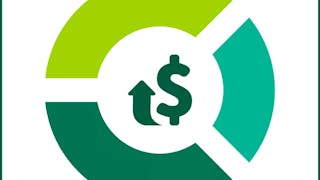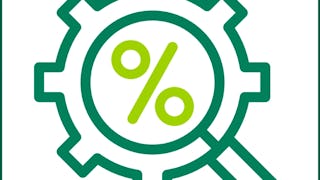How much should you charge for your products and services? Traditionally, businesses have answered this question based on the cost to produce or provide their goods and services. This course shows you the economic factors behind pricing based on cost and the pros and cons of a cost-based pricing approach. Developed at the Darden School of Business at the University of Virginia, and led by top-ranked Darden faculty and Boston Consulting Group global pricing experts, the course provides the practical and research-based models and methods you need to set prices that maximize your profits.


Ends tomorrow: Get a Black Friday boost with $160 off 10,000+ programs. Save now.



Cost and Economics in Pricing Strategy
This course is part of Pricing Strategy Optimization Specialization



Instructors: Jean Manuel Izaret
37,236 already enrolled
Included with
(687 reviews)
Recommended experience
What you'll learn
How to apply knowledge of basic economics to make better pricing decisions
How to recognize opportunities for price discrimination and recommend strategies to maximize sales and profits
How to calculate three types of price elasticities to determine the impact of price on demand
How to analyze and apply different pricing models, including: cost-plus pricing, marginal cost-plus pricing, peak-load pricing, index-based pricing.
Skills you'll gain
Details to know

Add to your LinkedIn profile
See how employees at top companies are mastering in-demand skills

Build your subject-matter expertise
- Learn new concepts from industry experts
- Gain a foundational understanding of a subject or tool
- Develop job-relevant skills with hands-on projects
- Earn a shareable career certificate

There are 4 modules in this course
Welcome to the first week of Cost and Economics in Pricing Strategy course! We'll begin our study of pricing by looking at some basic economic principles relevant to pricing, such as cost and cost variations and what that implies about the supply curve. Then we'll take a closer look at one pricing mechanism: auctions. You will never look at eBay the same!
What's included
13 videos4 readings3 assignments1 discussion prompt
This week we'll tackle three areas that will help you improve the effectiveness of your pricing strategy. First, we'll take a look at price discrimination and how to set prices for different customer segments to maximize profits. You'll learn about the price and margin waterfall and how creating one for your business can help identify "leaks" that you can prevent. Then we'll examine volume-based pricing, or pricing differently for different volumes to encourage consumption, of a consumer product: Heinz Ketchup. When we're done, you'll be very aware of the impact package size has on your own consumption--and how to use this knowledge to price products.
What's included
12 videos1 reading4 assignments
This week we'll dive deep into the world of demand modeling. We'll start with a brief overview of regressions--what they are, why they're useful and how to calculate them using Excel. Then you'll get a chance to use regressions as you learn about three types of elasticities--relationships between demand and price or other factors--and the drivers of these elasticities. We'll finish with a price optimization based on demand models--a truly useful method for pricing based on economic factors. By the end of this week, you'll be able to impress your colleagues and friends with your knowledge of mathematical models and how to use them to inform your pricing strategy!
What's included
13 videos3 assignments
Welcome to our final week together in this course! We'll finish by discussing key concepts related to channel pricing--or pricing through the supply chain. You'll learn about double-marginalization, time value of money, and customer lifetime value (CLV)--not only what they are, but how to use them to improve pricing decisions. Then we'll show you three different pricing techniques that you can use to improve direct-to-consumer pricing. You'll finish with a real-world case analysis of Retail Relay, an online grocery ordering and delivery service. You'll be able to recommend a viable approach to their pricing dilemma based on knowledge from this course. Enjoy!
What's included
16 videos1 reading4 assignments1 peer review1 discussion prompt
Earn a career certificate
Add this credential to your LinkedIn profile, resume, or CV. Share it on social media and in your performance review.
Explore more from Marketing
 Status: Free Trial
Status: Free TrialUniversity of Virginia
 Status: Free Trial
Status: Free TrialUniversity of Virginia
 Status: Free Trial
Status: Free TrialIE Business School
 Status: Free Trial
Status: Free TrialUniversity of Virginia
Why people choose Coursera for their career




Learner reviews
687 reviews
- 5 stars
83.30%
- 4 stars
13.20%
- 3 stars
2.03%
- 2 stars
0.29%
- 1 star
1.16%
Showing 3 of 687
Reviewed on Mar 10, 2018
A good course but there were places where I felt things weren't clearly explained. Also, the quiz questions were sometimes somewhat ambiguous.
Reviewed on Nov 24, 2019
Amazing! price has been most of the time an uncertainty . This course gives you the learning you need for allocating pricing strategies to the right business scenario
Reviewed on Oct 10, 2018
Great course. Has good coverage of important concepts and is delivered very well. Really useful course for those with interest in strategic pricing.

Open new doors with Coursera Plus
Unlimited access to 10,000+ world-class courses, hands-on projects, and job-ready certificate programs - all included in your subscription
Advance your career with an online degree
Earn a degree from world-class universities - 100% online
Join over 3,400 global companies that choose Coursera for Business
Upskill your employees to excel in the digital economy
Frequently asked questions
To access the course materials, assignments and to earn a Certificate, you will need to purchase the Certificate experience when you enroll in a course. You can try a Free Trial instead, or apply for Financial Aid. The course may offer 'Full Course, No Certificate' instead. This option lets you see all course materials, submit required assessments, and get a final grade. This also means that you will not be able to purchase a Certificate experience.
When you enroll in the course, you get access to all of the courses in the Specialization, and you earn a certificate when you complete the work. Your electronic Certificate will be added to your Accomplishments page - from there, you can print your Certificate or add it to your LinkedIn profile.
Yes. In select learning programs, you can apply for financial aid or a scholarship if you can’t afford the enrollment fee. If fin aid or scholarship is available for your learning program selection, you’ll find a link to apply on the description page.
More questions
Financial aid available,
¹ Some assignments in this course are AI-graded. For these assignments, your data will be used in accordance with Coursera's Privacy Notice.



